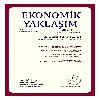Keynes Devrimi ve Keynesyen İktisat
Keynes’s Revolution and Keynesian Economics
___
- ALADA, Dinç (2000), İktisat Felsefesi ve Belirsizlik, Bağlam Yayıncılık, İstanbul.
- ASIMAKOPULUS, A.(1978), “Keynesian Economics, Equilibrium and Time”, The Canadian Journal Of Economics, Vol.11, Issue Supplement: The Harry G.Johnson Memorial Symposium (November 1978).
- BALL, Laurence, MANKIW, N. Gregory, ROMER, David (1988), “The New Keynesian Economics and The Output- Inflatıon Trade-Off”, Brookings Papers On Economic Activity, No.1 (1988).
- BLEANEY, Michael (1985), The Rise and Fall Of Keynesian Economics, An investigationof its contribution to capitalist development, St. Martin’s Press, New York.
- BLINDER, Alan S.(1987), “Keynes, Lucas, and Scientific Progress”, Journal Of Economics, Vol.19, Issue 1 (November 1986).
- BLINDER, Alan S.(1988), “The Fall and Rise Of Keynesian Economics” A Macroeconomics Reader içinde (der.Brian Snowdon ve Howard R.Vane), Routledge, London and New York.
- BUĞRA, Ayşe (1995), İktisatçılar ve İnsanlar, Bir Yöntem Çalışması, 1.Baskı, İletişim Yayınları, İstanbul.
- CODDINGTON, Alan (1979), “Hicks’s Contribution To Keynesian Economics” Journal Of Economic Literature, Vol.XVII (September 1979).
- EREN, Ercan, BİLDİRİCİ, Melike (1997), “İktisat Teorilerinde Son Gelişmeler”, İktisat Dergisi, Sayı: 365, Mart 1997.
- EROL, Ümit (1997), Eleştirel Bir Gözle Serbest Piyasa, Bağlam Yayıncılık, İstanbul.
- FELDERER, Bernard, HOMBURG, Stefan (1987), Macroeconomics and New Macroecomonics, Springer-Verlag, Berlin Heidelberg.
- FONTAINE, Philippe, JOLINK, Albert (1998), Historical Perspectives On Macroeconomics, Sixty Years After The General Theory, Routledge, London and New York.
- GERRAD, Bill (1995), “Keynes, The Keynesians and The Classics: A Suggested Interpretation”, The Economic Journal, Vol.105, (March, 1995).
- GREENWALD, Bruce, STIGLITZ, Joseph E. (1993), “New and Old Keynesians” Journal of Economic Perspectives, Vol.7, Number 1., Winter 1993.
- HOWITT, Peter (1986), “The Keynesian Recovery”, The Canadion Journal of Economics, Vol.19, Issue 4 (November 1986).
- JOHNSON, Harry J.(1971), “The Keynesian Revolution and the Monetarist Counter-Revolution”, The American EC.Rview. Vol.61, ıssue2, Papers and Proceedings Of The Ninety-Sixth Annual Meeting Of The American Economic Association (May 1971).
- KAZGAN, Gülten (1991), İktisadi Düşünce veya Politik İktisadın Evrimi, Remzi Kitabevi, İstanbul.
- LEIJONHUFVUD, Axel (1968), On Keynesian Economics and the Economics of Keynes, A Study in Monetary Theory, Oxford University Press, London.
- MANKIW, Gregory N.(1990) “A Quick Refresher Course in Macroeconomics”, Journal Of Economic Literature, Vol.XXXVIII (December, 1990).
- MANKIW, Gregory N. (1992), “The Reincarnation of Keynesian Economics”, A Macroeconomies Reader içinde (der. Brian Snowdon ve Howard R.Vane (1997)) , Routledge, Newyork.
- MAYER, Thomas (1987), “What remains of the monetarist counter-revolution?”, Reflections On The Development Of Modern Macroeconomics içinde (der.Brian Snowdon ve Howard R.Vane), Edward Elgar Publishers, Cheltenham, UK.
- MELTZER, Alan H.(1988), Keynes’s Monetary Theory A Different İnterpretation, Cambridge University Press, Cambridge.
- NIEHANS, Jürg (1990), A History Of Economic Theory, Classic Contributions, 1720-1980, The Johns Hopkins University Press, Baltimore and London.
- PARASIZ, İlker (1992), Para Banka ve Finansal Piyasalar, 4.Baskı, Ezgi Kitabevi, Bursa.
- PAYA, Merih (1994), Para Teorisi ve Para Politikası, 1.Baskı, Filiz Kitabevi, İstanbul.
- SAVAŞ, Vural (1984), Keynezyen İktisat Yıkılırken, Fatih Yayınevi, İstanbul.
- SAVAŞ, Vural, F.(1998), İktisatın Tarihi, 2.Baskı, Avcıol Basım-Yayın, İstanbul.
- SCREPANTI, Ernesto, ZAMAGNI, Stefano (1995), An Outline Of The History OfEconomic Thought (Translated by David Field), Clarendan Press, Oxford.
- SHAW, G.K.(1997), “How Relevant Is Keynesian Economics Today?”, Reflections On The Development Of Modern Macroeconomics içinde (der. Brian Snowdon ve Howard R.Vane), Edward Elgar Publishers, Cheltenham, UK.
- STALEY, Charles E.(1993), A History Of Economic Thought, From Aristotle to Arrow, Blackwell, Cambridge MA & Oxford UK.
- STEIN, Jerome (1981), “Monetorist, Keynesian and New Classical Economics”, The
- American Economic Review, Vol.71, Issue 2. Papers and Proceedings Of The Ninety-Sixth Annual Meeting Of The American Economic Association (May 1981).
- STEWART, Michael (1986), Keynes and After, Third Edition, Penguin Books, Snowdon, Brion ve Vane, Howard, R. (1997) “To Stabilize Or Not To Stabilize: Is That The Question?”, Reflections On the Development of Moden Macroeconomics (Edited by Brian Snowdon ve Howard R. Vane), Edward Elgar Publishers, Cheltenham, UK.
- SNOWDON, Brian, VANE, Howard R. (1997), Reflections on the Development of Modern Macroeconomics içinde (der. Snowdon, Brian ve Vane, Howard R.), EdwarElgar,U.K.
- TEKEOĞLU, Muammer (1993), İktisadi Düşünceler Tarihi, Çukurova Üniversitesi Basımevi, Adana.
- TOBIN, James (1993), “Price Flexibility and Output Stability An Old Keynesian View”, Journal Of Economic Perspectives, Vol.7, Number 1, Winter 1993.
- TOPRAK, Metin (1999), Yeni İktisat, İz Yayıncılık, İstanbul.
- ISSN: 1300-1868
- Yayın Aralığı: 3
- Yayıncı: Ekonomik Yaklaşım Derneği
Kuyumculuk Kümeleri: İstanbul Kapalıçarşı ile Dünya Örneklerinin Karşılaştırmalı Değerlendirmesi
Aysu UĞURLAR, Tanyel ECERAL ÖZELÇİ, Bilge KÖROĞLU ARMATLI
Hazine Borç Yönetiminde Risk Analizi Uygulamasının Yasal ve İdari Açıdan Değerlendirilmesi
Keynes Devrimi ve Keynesyen İktisat
Mahir FİSUNOĞLU, Bilge TAN KÖKSAL
